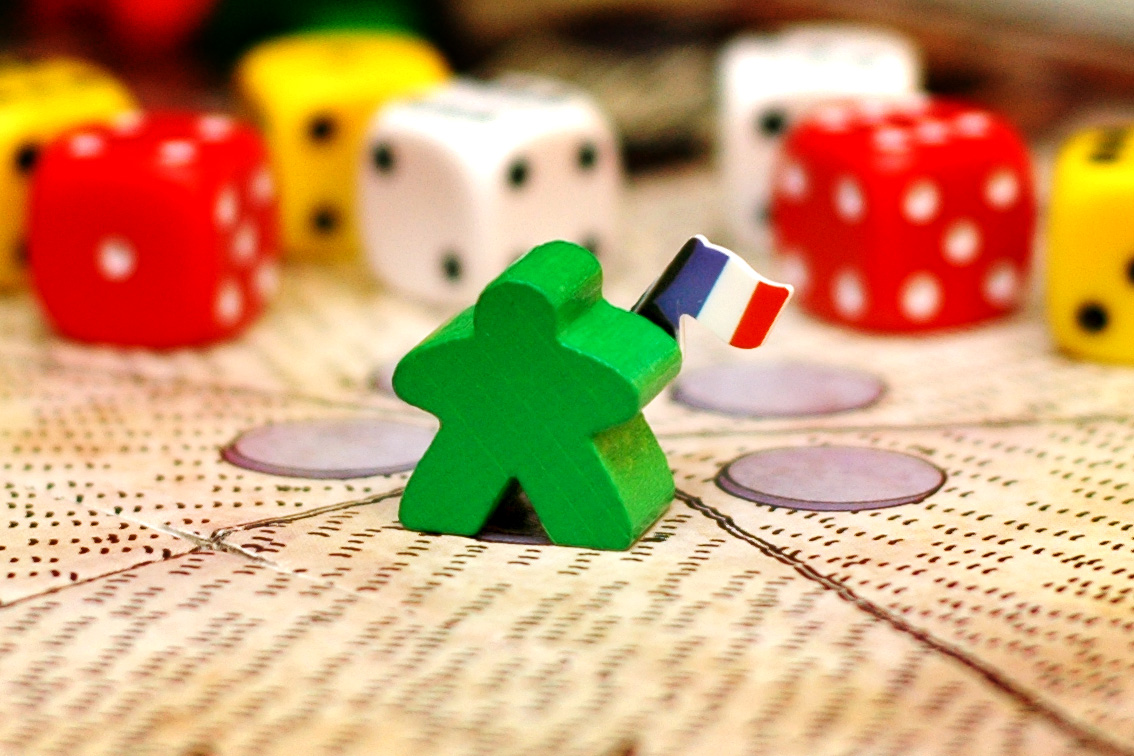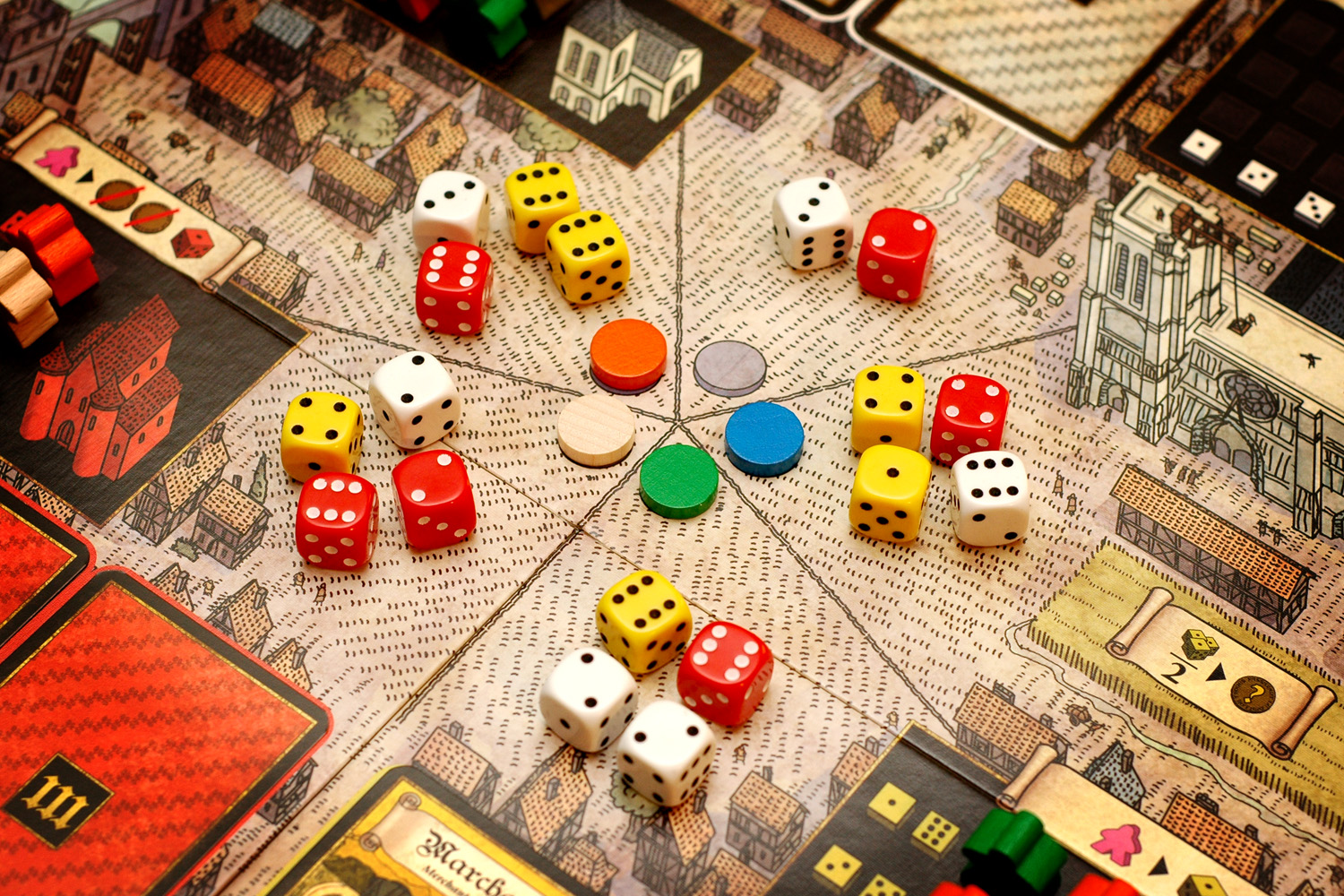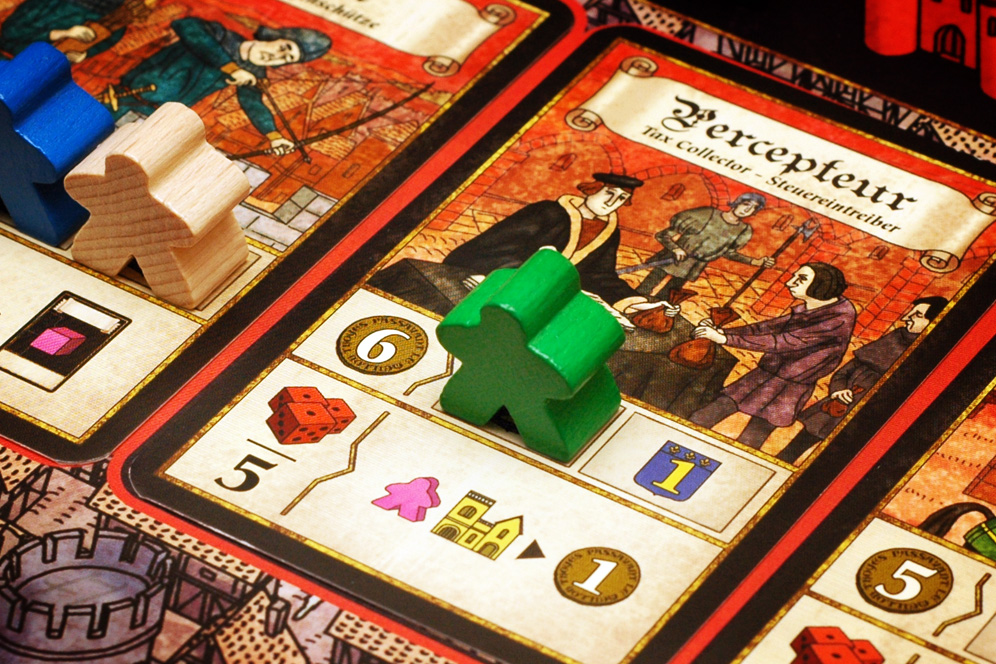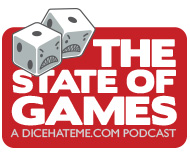The French Revelation: A Troyes Revue
In the past few years, the realms of boardgaming have traditionally been broken down into two main categories: “Ameritrash” — which typically includes those games with lots of plastic sculpted miniatures used to bash the crap out your opponent, along with tons of shiny dice — and “Euro” games, which usually include a dazzling array of choices in which to stoically quell the machinations of your opponent with feathered subtleties like influence, victory points, wooden cubes and meeples. Pearl Games has chosen to walk the insane path of including flavors from both realms in one box with their first release, Troyes. Despite their dabbling in “Ameritrash” sensibilities however, gamers can still safely call this one a “Euro” because you don’t get much more “Euro” than ordering workers around a lesser-known 13th-century town in the Champagne region of France.
This worker placement-ish, resource management-type, medieval dice-fest centers around the oh-so-very French city of Troyes, which is located about 100 miles from gay Paris and is steeped in the oh-so-very French history of building lots of churches, trading frilly things, getting smacked about by various invading forces, and catching on fire. During the game, each player does their best to manage a workforce represented by three colored sets of dice. These dice are used to do various things around the city such as collect taxes, go farming, or build part of a cathedral. You know, medieval French stuff.
At the beginning of the game, players take turns placing their starting number of French meeples (freeples?) inside one of three principal buildings that govern a district of the city – the Palace, the Bishopric or City Hall. The number of freeples a player has inside these buildings will determine how many dice of a particular color will be in their personal workforce for the turn. For instance, a player with two freeples inside the Palace will gather and roll two red dice at the beginning of each turn.
Various activity and event cards will be revealed throughout the game, and each card requires a certain total value provided by one to three same-colored dice in order to activate an ability or gain influence, coins (deniers) or victory points. Players may use dice from their personal workforce, or they may use dice from other players’ workforce, but they’ll have to pay the other players for their dice. This key mechanic is really the unique driving force behind Troyes.
An intriguing aspect of the workforce assembly is the tactical depth each player must exercise each round. For instance, rolling high when assembling your workforce is not always a good thing, especially if you’re close to the end in turn order. If you’re holding onto a lot of fives and sixes, chances are they’re going to be bought before you get a chance to use them. Granted, you’ll probably be rolling in deniers, but money doesn’t count towards victory in Troyes, which means you’ll have little choice but to spend that money to buy someone else’s dice. Intelligent management of influence (that is usually gained through countering certain events) can balance some of this, as players can spend this influence to reroll a die in their personal workforce, or flip up to three dice to their opposite faces. This can turn those pesky ones and twos into much more helpful fives and sixes.
Effectuer des Actions
There are so many ways to use dice for actions in this game that it would require a fortnight and a slide rule to cover all the details. Thus, I will try to summarize as best I can.
- Activate an activity card from one of the districts in the city. These range from making some deniers, to gaining influence or victory points, to the very evil “collect deniers from players who have freeples in City Hall.” Typically, this card is only fun for about one player.
- Construct the cathedral. There are three levels in the cathedral. If a player doesn’t have a colored cube on each level by the end of the game, they lose two victory points per level.
- Combat events. At the beginning of each round, event cards are turned over which represent forces acting against the city. Events can range from the Succession Conflict where interlopers might kick a freeple out of the Palace, to pesky Normans attacking the city. Again. Don’t you hate it when that happens? If these event cards are not countered, they will be activated again in every subsequent round. Combating an event grants influence points, as well as victory points to the player(s) that put the most (and second-most) effort into combating that event.
- Place a freeple on a principal building. This involves taking a die of the appropriate color, finding the spot that corresponds to its value, putting your freeple there and then kicking some poor bastard out of the building.
- Use agriculture. Use up to three yellow dice and earn a number of deniers equal to the total value of the group of dice divided by two, rounded down. Tantamount to begging, but every now and then you need an extra denier.
So, yeah, there you go. Apparently, there’s lots to do in 13th-century France. Go figure.
Pensées ensemble
Troyes has been called many things in the past few months since its introduction at Essen Spiel in 2010; an “evolutionary step,” a “dice-haters dream,” or the “ultimate gamers game.” I don’t know about all that, but I can agree with what Michael Harrison from Geekdad said when I first introduced him to the game this week: Troyes is “meaty.” What a very un-French thing to say. I love it.
| Gameplay/Replay | Components & Theme | Fun |
|---|---|---|
| Overall score: 15 out of 18 - If you’re really into medieval French history - or are just looking for a deep, euro-style game with some mechanical twists - I recommend you pick this up toot de suite. | ||
Troyes is a game for 2-4 joueurs, ages 12 and up, by Sébastien Dujardin, Xavier Georges and Alain Orban, from Pearl Games and Z-Man Games. It retails for $54 at Funagain Games, or you can hope that your favorite local game store has it in stock.
Related posts:
- Baby, It’s Cold Outside – A Twilight Struggle Review
- The Crowded Table: April/May Edition
- Races of Twilight Imperium
- Dice Hate Me at the Bookstore: The Games Bible
- Great Odin’s Goat! A Trollhalla Review
Comments
8 Responses to “The French Revelation: A Troyes Revue”Trackbacks
Check out what others are saying...-
[…] or detriment to the rest of gameplay. It’s a little bit reminiscent of the recently-released Troyes, or – dare I say it? – Alien […]
-
[…] to Boardwalk a few times in the family parlor. For prime examples of “gamer’s games,” see: Troyes, Twilight Struggle, Puerto Rico; do not see: Clue, Settlers of Catan, Ticket to Ride. Designer […]







The review covered the game well. I enjoyed Troyes. It took me a few turns to get what was going on. And I still need a couple of plays to feel like I’m holding my own but it was interesting enough that I would like to play it more. There is so very much going on and so many options every turn. The first few turns were very confusing but my head cleared some as I watched and learned. We made the complarison to Macao after our game. It is similar but not as engaging to me. It’s thinky fun.
Great review, Chris. I think my exhaustion might have influenced my initial thoughts on the game, and after some consideration, I’ve bumped my 6.5 up to a solid 8. I’m really interested in playing this one again. What can I say? I love meaty things.
Tom and Michael – Thanks for the kudos. I couldn’t have done it without you – literally! I’m glad you both got a chance to play Troyes with me. I’m looking forward to the next play now that you both know more of what’s going on in the game. The more I think about Troyes, the more I really want to get deeper into the game. It’s the first “euro” in awhile that has captivated me enough to get my brain churning when I’m not playing the game.
chris, thanks for your fine review! i am glad we got to email about this a bit, and i find your review spot on. i think 15/18 is a solid score, and befitting this game. while on the surface, plain… (especially with the artwork), there is something that lures me to play again (and again). def. a ‘meaty’ game, and one i dont regret buying at all!
-ginny
customk9design
Ginny – Yes, it’s been good talking with you about Troyes. It really is an interesting game, and it succeeds in being captivating because I can’t wait to break it out again! Thanks for reading, and please comment often. 🙂
Love this review.. am downloading the rules and playing this at a game meetup in a couple of weeks and I am way stoked. I would be more stoked if offers I am making for this RATHER pricey game at BGG marketplace would stop being denied. 🙂 When you buy TONS andTONS of games like I do.. unless you play a game three times and fall WHOLLY AND MADLY in love with it, 45 to 60 bucks is kinda steep.